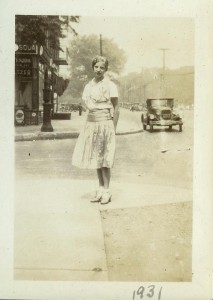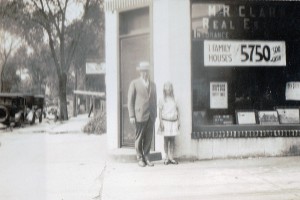I have been looking at lots and lots of photos lately – mostly of my mother-in-law, Ella Mabel Corke. Her recent death at 99 – almost 100 – prompted a sifting of hundreds of photos. Ella’s family always seemed to have a camera at the ready, so her long, full life is well documented pictorially. I found myself studying two particular photos closely.
The first, from 1927, shows Ella with her beloved father, Marvin Ray Clark, standing in front of his real estate and insurance business in Richmond Hill (Queens), New York. Twelve-year-old Ella, wearing a drop-waist dress and patterned knee socks, was already taking dance lessons – and it looks like she’s standing in first position. Her 46-year-old widowed father is wearing a suit, boater, and round spectacles.
But in addition to their 1920s attire, we see 1920s-era automobiles – perhaps Model T Fords? – parked along the street. I find myself fascinated by the signage in the window, advertising a single-family home for $5,750 with only $500 down. These details make me conjecture: Had Ella had been given the rare treat of going to work with her dad? Was one of the cars their own, and were they going to drive off and visit one of the properties Marvin was selling – or perhaps drop Ella at dance class?
 In the second photo, from four years later, Ella is standing on a corner, smiling demurely, wearing a dress, anklets, and slightly high heels. Her hair has a wave. We also see part of a store and a long string of cars, with perhaps a Model A in the near background. The ads on the storefront signal a drug store, selling hairnets and seltzer – and, as you can tell from the logo under the window, Breyer’s ice cream. The small white circle to the right of the Breyer’s ad has the Bell Telephone symbol: the store had a public telephone.
In the second photo, from four years later, Ella is standing on a corner, smiling demurely, wearing a dress, anklets, and slightly high heels. Her hair has a wave. We also see part of a store and a long string of cars, with perhaps a Model A in the near background. The ads on the storefront signal a drug store, selling hairnets and seltzer – and, as you can tell from the logo under the window, Breyer’s ice cream. The small white circle to the right of the Breyer’s ad has the Bell Telephone symbol: the store had a public telephone.
Perhaps Ella had been to the store to buy a hairnet; as a dancer, she would have needed one for a ballet bun. Or maybe she had used the public phone to call her older brother Ray to pick her up. Or at age 15 or 16, might she have gone for an ice cream soda with a date? If so, was her beau the photographer?
When I look at family photos now, I find myself turning more and more to photos like these, rather than to close-ups and portraits. Rich with detail, they draw you much more deeply into the person’s life, and into a particular time and place. It makes me wonder which photos of my own family will yield such detail to viewers of the future.
For another approach to this question, read Jean Powers's post here.
Share this:
About Penny Stratton
A veteran of the book publishing industry, Penny Stratton retired as NEHGS Publishing Director in June 2016; she continues to consult with the Society on publications projects. Among the more than 65 titles she managed at NEHGS are The Great Migration Directory, Elements of Genealogical Analysis, Genealogist’s Handbook for New England Research, and the award-winning Descendants of Judge John Lowell of Newburyport, Massachusetts. She has written for American Ancestors magazine and is a regular poster on Vita Brevis. With Henry B. Hoff, Penny is coauthor of Guide to Genealogical Writing: How to Write and Publish Your Family History; she is also the author of several Portable Genealogists on writing and publishing topics.View all posts by Penny Stratton →
